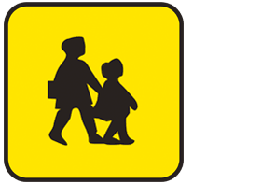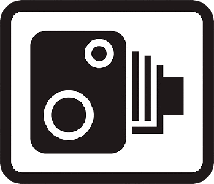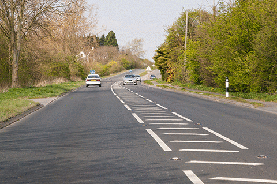The duration of this ADI theory test is 90 minutes (1 hour 30 minutes). There are 100 multiple choice questions. You need at least 85/100 to pass. Click the Begin Test button when you're ready to start. You may review your answer after each question or wait until the end to view your overall result. Good luck!
Test Quick View
Click on an answer to view the correct choice along with the explanation.
1. A physically disabled driver passes their driving test in a specially adapted vehicle. How will their driving licence be restricted?
Mark one answer
B
C
D
Correct Answer: A
Explanation: When a physically disabled driver passes their driving test in a specially adapted vehicle, the licence issued will include restrictions. These will require the necessary modifications to be fitted to any vehicle they drive.
Explanation: When a physically disabled driver passes their driving test in a specially adapted vehicle, the licence issued will include restrictions. These will require the necessary modifications to be fitted to any vehicle they drive.
2. What's the minimum distance from which an examiner will ask a driving-test candidate to read a modern-style number plate?
Mark one answer
B
C
D
Correct Answer: B
Explanation: A candidate must be able to read a modern-style number plate (made after 1 September 2001) from 20 metres. If the candidate's eyesight isn't up to the required standard, the test will go no further and they'll have failed.
Explanation: A candidate must be able to read a modern-style number plate (made after 1 September 2001) from 20 metres. If the candidate's eyesight isn't up to the required standard, the test will go no further and they'll have failed.
3. You're driving at night. What does it mean if you see a pedestrian wearing reflective clothing and carrying a red light?
Mark one answer
B
C
D
Correct Answer: C
Explanation: The people involved in an organised walk should be keeping to the left. The walker at the back of the group should be showing a red light, while the one at the front should show a white light. Pass slowly and safely, and be aware that the pedestrians have their backs to you and might not know that you're there.
Explanation: The people involved in an organised walk should be keeping to the left. The walker at the back of the group should be showing a red light, while the one at the front should show a white light. Pass slowly and safely, and be aware that the pedestrians have their backs to you and might not know that you're there.
Correct Answer: D
Explanation: When renewing your vehicle tax, you must have valid insurance cover for the vehicle. It's illegal to drive or keep a vehicle on public roads without insurance cover.
Explanation: When renewing your vehicle tax, you must have valid insurance cover for the vehicle. It's illegal to drive or keep a vehicle on public roads without insurance cover.
Correct Answer: C
Explanation: Late braking and harsh acceleration waste fuel. To avoid this, scan and look well ahead so that you can recognise hazards and anticipate problems in good time.
Explanation: Late braking and harsh acceleration waste fuel. To avoid this, scan and look well ahead so that you can recognise hazards and anticipate problems in good time.
6. You're about to reverse into a side road. What should you do if you see a pedestrian who wants to cross behind your car?
Mark one answer
B
C
D
Correct Answer: A
Explanation: Look all around before and during any manoeuvre. Always stop and give way to any pedestrians who wish to cross the road behind your vehicle. The shape and size of your vehicle can restrict visibility; be aware that there may be a small child or a low obstruction hidden from view.
Explanation: Look all around before and during any manoeuvre. Always stop and give way to any pedestrians who wish to cross the road behind your vehicle. The shape and size of your vehicle can restrict visibility; be aware that there may be a small child or a low obstruction hidden from view.
7. What advice should you give to someone who intends to drive a left-hand-drive vehicle in the UK?
Mark one answer
B
C
D
Correct Answer: C
Explanation: In a left-hand-drive vehicle, use of the mirrors and awareness of blind areas is very important. Being seated on the car's left makes the blind area on your right more difficult to overcome. For example, when joining a dual carriageway or motorway from a slip road, traffic on the carriageway will be approaching in the blind area on your right and could easily be overlooked.
Explanation: In a left-hand-drive vehicle, use of the mirrors and awareness of blind areas is very important. Being seated on the car's left makes the blind area on your right more difficult to overcome. For example, when joining a dual carriageway or motorway from a slip road, traffic on the carriageway will be approaching in the blind area on your right and could easily be overlooked.
B
C
D
Correct Answer: C
Explanation: A properly adjusted head restraint can help to prevent whiplash injury to the neck and spine. You're most likely to suffer this type of injury if you're hit from behind by another vehicle.
Explanation: A properly adjusted head restraint can help to prevent whiplash injury to the neck and spine. You're most likely to suffer this type of injury if you're hit from behind by another vehicle.
Correct Answer: C
Explanation: To reduce the risk of wheelspin when moving off on a slippery surface, use a higher gear than normal. This will reduce the amount of torque transmitted to the driven wheels. Gentle use of the accelerator will also make it easier for the tyres to keep their grip.
Explanation: To reduce the risk of wheelspin when moving off on a slippery surface, use a higher gear than normal. This will reduce the amount of torque transmitted to the driven wheels. Gentle use of the accelerator will also make it easier for the tyres to keep their grip.
10. What should you do if you have to treat someone for shock at the scene of a collision?
Mark one answer
B
C
D
Correct Answer: C
Explanation: Stay with the casualty and talk to them confidently to reassure them. Avoid moving them unnecessarily, in case they're injured. Keep them warm, but don't give them anything to eat or drink.
Explanation: Stay with the casualty and talk to them confidently to reassure them. Avoid moving them unnecessarily, in case they're injured. Keep them warm, but don't give them anything to eat or drink.
11. At an incident, a casualty has stopped breathing. What should you do to help them?
Mark one answer
B
C
D
Correct Answer: A
Explanation: When someone has stopped breathing, their airway should be checked and unblocked if necessary. Gently tilting their head back will ensure it's kept open.
Explanation: When someone has stopped breathing, their airway should be checked and unblocked if necessary. Gently tilting their head back will ensure it's kept open.
Correct Answer: B
Explanation: When following a large vehicle, keep well back. If you're too close, you won't be able to see the road ahead and the driver of the long vehicle might not be able to see you in their mirrors.
Explanation: When following a large vehicle, keep well back. If you're too close, you won't be able to see the road ahead and the driver of the long vehicle might not be able to see you in their mirrors.
Correct Answer: C
Explanation: Buses that carry children to and from school may stop at places other than scheduled bus stops. Be aware that they might pull over at any time to allow children to get on or off. This will often be when traffic is heavy during the daily commute.
Explanation: Buses that carry children to and from school may stop at places other than scheduled bus stops. Be aware that they might pull over at any time to allow children to get on or off. This will often be when traffic is heavy during the daily commute.
14. What should you check when you're leaving a motorway after driving at speed for some time?
Mark one answer
B
C
D
Correct Answer: C
Explanation: After leaving a motorway or when using a link road between motorways, your speed may be higher than you realise: 50 mph may feel like 30 mph. Check the speedometer and adjust your speed accordingly. Some slip roads and link roads have sharp bends, so you'll need to slow down.
Explanation: After leaving a motorway or when using a link road between motorways, your speed may be higher than you realise: 50 mph may feel like 30 mph. Check the speedometer and adjust your speed accordingly. Some slip roads and link roads have sharp bends, so you'll need to slow down.
Correct Answer: B
Explanation: This curved arrow on the road indicates the direction that traffic should pass solid double white lines that are coming up. These arrows are also used on the approach to hatch markings and low arched bridges. Sometimes the arrow may curve to the right.
Explanation: This curved arrow on the road indicates the direction that traffic should pass solid double white lines that are coming up. These arrows are also used on the approach to hatch markings and low arched bridges. Sometimes the arrow may curve to the right.
16. What advice should you give to a pupil who asks whether it's permitted to drive on the hatch markings?
Mark one answer
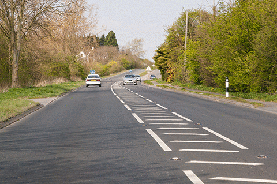
B
C
D
Correct Answer: A
Explanation: Hatch markings are used to separate traffic and to protect traffic turning right. Where the boundary line is broken, you may enter the area only if necessary and provided you can see that it's safe. A continuous white line defining the hatched area means that you mustn't enter, except in an emergency. All other rules of the road apply as normal.
Explanation: Hatch markings are used to separate traffic and to protect traffic turning right. Where the boundary line is broken, you may enter the area only if necessary and provided you can see that it's safe. A continuous white line defining the hatched area means that you mustn't enter, except in an emergency. All other rules of the road apply as normal.
17. You're giving a driving lesson in an unfamiliar town. What should you tell your pupil if you see this sign?
Mark one answer

B
C
D
Correct Answer: A
Explanation: This sign indicates a route for trams only. Other vehicles aren't allowed to use these routes. Drivers need to look ahead and plan - especially in an unfamiliar area.
Explanation: This sign indicates a route for trams only. Other vehicles aren't allowed to use these routes. Drivers need to look ahead and plan - especially in an unfamiliar area.
Correct Answer: C
Explanation: This sign reminds all road users that they're entering an area where cameras will monitor traffic regulations. This could include traffic-light cameras and bus-lane cameras, as well as the more common speed cameras.
Explanation: This sign reminds all road users that they're entering an area where cameras will monitor traffic regulations. This could include traffic-light cameras and bus-lane cameras, as well as the more common speed cameras.
Correct Answer: B
Explanation: This blue circular sign indicates a route available only to the class of vehicle shown. Plan ahead so that when you see the sign, you have time to take another route; this may be indicated by other traffic signs.
Explanation: This blue circular sign indicates a route available only to the class of vehicle shown. Plan ahead so that when you see the sign, you have time to take another route; this may be indicated by other traffic signs.
20. As you're approaching this junction, the green light changes to amber. What should you do if you're unable to stop at the first white line?
Mark one answer
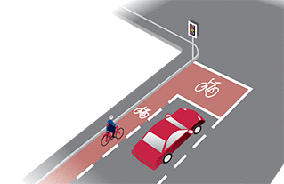
B
C
D
Correct Answer: C
Explanation: Some junctions have advanced stop lines with an area for cyclists to position themselves ahead of other traffic. You must stop at the first white line you reach. If you're unable to stop safely at the first line, you must stop at the second line, even though you'll be blocking the area reserved for cyclists.
Explanation: Some junctions have advanced stop lines with an area for cyclists to position themselves ahead of other traffic. You must stop at the first white line you reach. If you're unable to stop safely at the first line, you must stop at the second line, even though you'll be blocking the area reserved for cyclists.

B
C
D
Correct Answer: D
Explanation: Hatch markings bounded by broken white lines are designed to separate traffic lanes or to protect traffic turning right. Only drive into these areas if it's necessary and you can see that it's safe.
Explanation: Hatch markings bounded by broken white lines are designed to separate traffic lanes or to protect traffic turning right. Only drive into these areas if it's necessary and you can see that it's safe.
B
C
D
Correct Answer: B
Explanation: If the number of points on a new driver's licence (including any points gained as a learner) reaches six or more within two years of passing their first practical driving test, their licence will be revoked. To regain a full driving licence, both the theory and practical tests will have to be retaken.
Explanation: If the number of points on a new driver's licence (including any points gained as a learner) reaches six or more within two years of passing their first practical driving test, their licence will be revoked. To regain a full driving licence, both the theory and practical tests will have to be retaken.
23. Which vehicle should display a flashing amber light when it's being used on a dual carriageway?
Mark one answer
B
C
D
Correct Answer: A
Explanation: An amber flashing light on a vehicle indicates that it's slow-moving. Mobility scooters used by disabled people are limited to no more than 8 mph. On dual carriageways, they must display an amber flashing light.
Explanation: An amber flashing light on a vehicle indicates that it's slow-moving. Mobility scooters used by disabled people are limited to no more than 8 mph. On dual carriageways, they must display an amber flashing light.
Correct Answer: A
Explanation: Some vehicles are prohibited from using the motorway. These include motorcycles under 50 cc, cyclists, horse riders, agricultural vehicles and powered wheelchairs/mobility scooters.
Explanation: Some vehicles are prohibited from using the motorway. These include motorcycles under 50 cc, cyclists, horse riders, agricultural vehicles and powered wheelchairs/mobility scooters.
Correct Answer: A
Explanation: Large vehicles take time to get moving, especially on an uphill gradient. You should keep this in mind and give way, if you can do so safely, so that they can maintain momentum up the hill.
Explanation: Large vehicles take time to get moving, especially on an uphill gradient. You should keep this in mind and give way, if you can do so safely, so that they can maintain momentum up the hill.
26. How should you signal when you're going ahead at a roundabout and taking the second exit?
Mark one answer
B
C
D
Correct Answer: B
Explanation: When you approach a roundabout, look across it and identify the exit if you can. If you wish to go straight ahead, don't signal as you approach. You should then indicate left just after you pass the exit before the one you wish to take.
Explanation: When you approach a roundabout, look across it and identify the exit if you can. If you wish to go straight ahead, don't signal as you approach. You should then indicate left just after you pass the exit before the one you wish to take.
Correct Answer: A
Explanation: If you see a vehicle with a flashing green light, allow it to pass when you can do so safely; it will be a doctor on an emergency call. Someone's life could depend on the driver making good progress through the traffic.
Explanation: If you see a vehicle with a flashing green light, allow it to pass when you can do so safely; it will be a doctor on an emergency call. Someone's life could depend on the driver making good progress through the traffic.
Correct Answer: A
Explanation: Compulsory reduced speed limits are often in force throughout roadworks on the motorway. This safety measure is to protect drivers and workers in the road. Be aware of reduced speed limits and slow down in good time.
Explanation: Compulsory reduced speed limits are often in force throughout roadworks on the motorway. This safety measure is to protect drivers and workers in the road. Be aware of reduced speed limits and slow down in good time.
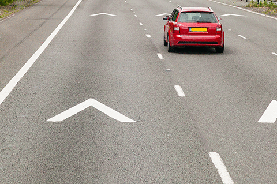
B
C
D
Correct Answer: D
Explanation: Chevrons are painted on the road surface to help you to judge a safe following distance. In good weather, at least two chevrons should be visible on the road surface between your vehicle and the vehicle directly ahead in your lane. Where there are no chevrons, you should use the two-second rule.
Explanation: Chevrons are painted on the road surface to help you to judge a safe following distance. In good weather, at least two chevrons should be visible on the road surface between your vehicle and the vehicle directly ahead in your lane. Where there are no chevrons, you should use the two-second rule.
30. Until you're 70 years old, how often should you renew your photocard driving licence?
Mark one answer
B
C
D
Correct Answer: A
Explanation: Photocard licences have to be renewed every 10 years until the age of 70. This is to make sure that the photograph is a good likeness of the licence holder.
Explanation: Photocard licences have to be renewed every 10 years until the age of 70. This is to make sure that the photograph is a good likeness of the licence holder.
Correct Answer: A
Explanation: If you wish to carry a heavy load on your vehicle, it's your responsibility to ensure that the load is secure and the vehicle isn't overloaded.
Explanation: If you wish to carry a heavy load on your vehicle, it's your responsibility to ensure that the load is secure and the vehicle isn't overloaded.
32. You're driving on a motorway. What does it mean if the car ahead shows its hazard warning lights for a short time?
Mark one answer
B
C
D
Correct Answer: D
Explanation: Hazard warning lights mustn't be switched on in normal driving. The exception is when driving on a motorway or unrestricted dual carriageway and there's a need to warn drivers behind of a hazard or obstruction ahead.
Explanation: Hazard warning lights mustn't be switched on in normal driving. The exception is when driving on a motorway or unrestricted dual carriageway and there's a need to warn drivers behind of a hazard or obstruction ahead.
33. Why should you allow extra room when you're overtaking a motorcyclist on a windy day?
Mark one answer
B
C
D
Correct Answer: A
Explanation: On a windy day, the blustery conditions will affect motorcyclists and they may be blown off course. If you wish to overtake a motorcyclist in these conditions, make allowances for them and give them extra room.
Explanation: On a windy day, the blustery conditions will affect motorcyclists and they may be blown off course. If you wish to overtake a motorcyclist in these conditions, make allowances for them and give them extra room.
34. You need glasses to bring your eyesight up to the required standard. When must you wear them?
Mark one answer
B
C
D
Correct Answer: A
Explanation: Drivers must be able to read a modern vehicle number plate from a distance of 20 metres. If you need glasses to do this, then you must wear them at all times when you're driving.
Explanation: Drivers must be able to read a modern vehicle number plate from a distance of 20 metres. If you need glasses to do this, then you must wear them at all times when you're driving.
35. You're driving a car. What should you do before answering a call on your mobile phone?
Mark one answer
B
C
D
Correct Answer: D
Explanation: It's illegal to use a hand-held phone while you're driving. Even using a phone with a hands-free system is potentially dangerous, as it will distract your attention. The safest action is to switch your phone off while you're driving and listen to your messages or make any calls when you've stopped the car in a safe place.
Explanation: It's illegal to use a hand-held phone while you're driving. Even using a phone with a hands-free system is potentially dangerous, as it will distract your attention. The safest action is to switch your phone off while you're driving and listen to your messages or make any calls when you've stopped the car in a safe place.
36. Which lights should you use if you're on a wet motorway where there's surface spray?
Mark one answer
B
C
D
Correct Answer: A
Explanation: In wet weather, visibility on the motorway is made worse by the spray thrown up from vehicles' tyres. Using dipped headlights will help other drivers to see you more easily.
Explanation: In wet weather, visibility on the motorway is made worse by the spray thrown up from vehicles' tyres. Using dipped headlights will help other drivers to see you more easily.
37. What should you do if you've just been overtaken by a motorcyclist who cuts back in front of you?
Mark one answer
B
C
D
Correct Answer: C
Explanation: Always drive defensively. If a vehicle cuts in after overtaking, it's important to re-establish a safe separation gap. Check the mirrors and drop back to maintain your safe gap.
Explanation: Always drive defensively. If a vehicle cuts in after overtaking, it's important to re-establish a safe separation gap. Check the mirrors and drop back to maintain your safe gap.
38. You're driving down a steep hill. Why could keeping the clutch down or selecting neutral for too long be dangerous?
Mark one answer
B
C
D
Correct Answer: D
Explanation: Driving in neutral or with the clutch down for long periods is known as 'coasting'. If you do this on a steep downhill gradient, there will be no engine braking to help check your speed.
Explanation: Driving in neutral or with the clutch down for long periods is known as 'coasting'. If you do this on a steep downhill gradient, there will be no engine braking to help check your speed.
39. You're driving along a residential road. What should you do if a car is reversing into your path from a driveway on your left?
Mark one answer
B
C
D
Correct Answer: C
Explanation: White lights at the rear of a car show that the driver has selected reverse gear. When reversing, the driver's view of the road is likely to be reduced. Sound your horn to warn of your presence and be ready to stop if necessary.
Explanation: White lights at the rear of a car show that the driver has selected reverse gear. When reversing, the driver's view of the road is likely to be reduced. Sound your horn to warn of your presence and be ready to stop if necessary.
Correct Answer: C
Explanation: Before moving off from behind a parked car, you should use all the mirrors to check that the road is clear. Look around to check the blind spots and give a signal if it's necessary to warn other road users of your intentions.
Explanation: Before moving off from behind a parked car, you should use all the mirrors to check that the road is clear. Look around to check the blind spots and give a signal if it's necessary to warn other road users of your intentions.
Correct Answer: B
Explanation: The brakes on your vehicle must be effective and properly adjusted. If your vehicle pulls to one side when braking, take it to be checked by a qualified mechanic. Don't take risks.
Explanation: The brakes on your vehicle must be effective and properly adjusted. If your vehicle pulls to one side when braking, take it to be checked by a qualified mechanic. Don't take risks.
Correct Answer: C
Explanation: If you find yourself having to stop in an emergency, it's important that your vehicle remains under control. If you lose control, you may make the situation worse. Having both hands on the wheel during braking will help you to control the steering as you stop.
Explanation: If you find yourself having to stop in an emergency, it's important that your vehicle remains under control. If you lose control, you may make the situation worse. Having both hands on the wheel during braking will help you to control the steering as you stop.
43. You want to turn right at a box junction. What should you do if there's oncoming traffic?
Mark one answer
B
C
D
Correct Answer: D
Explanation: You can move into a box junction as long as your exit road is clear. You can stop and wait in the junction when you want to turn right and have to wait for a gap in the oncoming traffic.
Explanation: You can move into a box junction as long as your exit road is clear. You can stop and wait in the junction when you want to turn right and have to wait for a gap in the oncoming traffic.
44. You're driving in falling snow. What should you do if your wipers aren't clearing the windscreen?
Mark one answer
B
C
D
Correct Answer: A
Explanation: Before you set off, you should make sure that you can see clearly through all the windows. Don't just rely on the wipers to clear the front and rear, as this will leave dangerous blind spots. If you need to, pull up safely and clear the windows by hand.
Explanation: Before you set off, you should make sure that you can see clearly through all the windows. Don't just rely on the wipers to clear the front and rear, as this will leave dangerous blind spots. If you need to, pull up safely and clear the windows by hand.
Correct Answer: A
Explanation: If your car is fitted with an anti-lock braking system (ABS), this will activate when you brake so hard that the tyres start to lose their grip on the road surface. At this point, the wheels would normally lock up and a skid would start. The ABS senses the wheel locking and releases the brake pressure just enough to avoid the skid. It then cycles through applying and releasing the brake pressure many times per second. This ensures maximum braking for the available grip is constantly applied without the wheels locking.
Explanation: If your car is fitted with an anti-lock braking system (ABS), this will activate when you brake so hard that the tyres start to lose their grip on the road surface. At this point, the wheels would normally lock up and a skid would start. The ABS senses the wheel locking and releases the brake pressure just enough to avoid the skid. It then cycles through applying and releasing the brake pressure many times per second. This ensures maximum braking for the available grip is constantly applied without the wheels locking.
Correct Answer: C
Explanation: If you don't have your vehicle serviced regularly, the engine will steadily become less efficient. This loss of efficiency will progressively cause an increase in fuel consumption, engine running problems and increased risk of the vehicle breaking down.
Explanation: If you don't have your vehicle serviced regularly, the engine will steadily become less efficient. This loss of efficiency will progressively cause an increase in fuel consumption, engine running problems and increased risk of the vehicle breaking down.
Correct Answer: B
Explanation: It's against the law to drive on or over a footpath, except to gain access to a property. If you need to cross a pavement, watch for pedestrians in both directions.
Explanation: It's against the law to drive on or over a footpath, except to gain access to a property. If you need to cross a pavement, watch for pedestrians in both directions.
48. You're driving past a line of parked cars. What should you do if a ball suddenly bounces out into the road ahead?
Mark one answer
B
C
D
Correct Answer: C
Explanation: If a ball bounces out from the pavement, slow down and be ready to stop. Don't encourage anyone to step into the road to retrieve it, as other road users might not have seen the situation and may be unable to stop if someone steps into the road.
Explanation: If a ball bounces out from the pavement, slow down and be ready to stop. Don't encourage anyone to step into the road to retrieve it, as other road users might not have seen the situation and may be unable to stop if someone steps into the road.
Correct Answer: C
Explanation: Careless or thoughtless parking can create problems for other people. For example, if the kerb has been lowered to enable wheelchair access, then keep it clear. Don't park on the pavement, as this may create danger for pedestrians, who will have to move into the road to pass your vehicle. Think about the effect your parking will have on others.
Explanation: Careless or thoughtless parking can create problems for other people. For example, if the kerb has been lowered to enable wheelchair access, then keep it clear. Don't park on the pavement, as this may create danger for pedestrians, who will have to move into the road to pass your vehicle. Think about the effect your parking will have on others.
B
C
D
Correct Answer: A
Explanation: If you're taking medication that's likely to affect your driving, don't drive. You mustn't put other road users, your passengers or yourself at risk.
Explanation: If you're taking medication that's likely to affect your driving, don't drive. You mustn't put other road users, your passengers or yourself at risk.
51. You're invited to a pub lunch. What's your best course of action if you know that you'll have to drive in the evening?
Mark one answer
B
C
D
Correct Answer: B
Explanation: Alcohol remains in the body for several hours; this may make you unfit to drive a long time after having an alcoholic drink. If you know you'll be driving, the safest course is to avoid drinking any alcohol.
Explanation: Alcohol remains in the body for several hours; this may make you unfit to drive a long time after having an alcoholic drink. If you know you'll be driving, the safest course is to avoid drinking any alcohol.
52. You're driving towards a left-hand bend on a country road. What should you anticipate if there are no pavements?
Mark one answer
B
C
D
Correct Answer: D
Explanation: Pedestrians walking on a road with no pavement are advised to walk facing oncoming traffic. With this knowledge, you can anticipate their presence and so give yourself time to react, if necessary, as you negotiate the bend.
Explanation: Pedestrians walking on a road with no pavement are advised to walk facing oncoming traffic. With this knowledge, you can anticipate their presence and so give yourself time to react, if necessary, as you negotiate the bend.
Correct Answer: D
Explanation: When parking on a hill, there's a risk of the car rolling if the parking brake fails. To reduce this risk, turn the front wheels towards the kerb. This will allow the kerb to act as a chock, preventing any forward movement of the vehicle.
Explanation: When parking on a hill, there's a risk of the car rolling if the parking brake fails. To reduce this risk, turn the front wheels towards the kerb. This will allow the kerb to act as a chock, preventing any forward movement of the vehicle.
Correct Answer: D
Explanation: When all four wheels are driven, there's less chance of the tyres losing their grip, compared with a two-wheel-drive vehicle. But this doesn't replace the skills you need to drive safely. The extra grip helps to prevent skidding when travelling on slippery or uneven roads.
Explanation: When all four wheels are driven, there's less chance of the tyres losing their grip, compared with a two-wheel-drive vehicle. But this doesn't replace the skills you need to drive safely. The extra grip helps to prevent skidding when travelling on slippery or uneven roads.
Correct Answer: C
Explanation: Your tyres will have reduced grip on snow. This makes it easier for them to lose all grip, and spin. The engine will deliver the most turning force (torque) to the driven wheels when first gear is selected; in snow this may be too much for the available grip. Using the highest gear you can will reduce the torque and so help the tyres keep their grip.
Explanation: Your tyres will have reduced grip on snow. This makes it easier for them to lose all grip, and spin. The engine will deliver the most turning force (torque) to the driven wheels when first gear is selected; in snow this may be too much for the available grip. Using the highest gear you can will reduce the torque and so help the tyres keep their grip.
Correct Answer: C
Explanation: If you can assist someone moving sheep along the road by stopping and turning off your engine, then do so. This will help to reduce the time it takes to move the sheep and clear the road.
Explanation: If you can assist someone moving sheep along the road by stopping and turning off your engine, then do so. This will help to reduce the time it takes to move the sheep and clear the road.
57. Trams can move both quietly and quickly. What other feature of trams should you be especially aware of?
Mark one answer
B
C
D
Correct Answer: A
Explanation: Electric trams run on rails and can't steer to avoid you. Keep a lookout for trams in areas where they operate, as they move very quietly and you might not hear them approaching.
Explanation: Electric trams run on rails and can't steer to avoid you. Keep a lookout for trams in areas where they operate, as they move very quietly and you might not hear them approaching.
58. You're turning right onto a dual carriageway. What should you do before emerging?
Mark one answer
B
C
D
Correct Answer: A
Explanation: Before turning right onto a dual carriageway, make sure that the central reservation is wide enough to protect your vehicle. If it's not, you should treat the dual carriageway as one road and check that it's clear in both directions before pulling out. Otherwise, you could obstruct part of the carriageway and cause a hazard, both for yourself and for other road users.
Explanation: Before turning right onto a dual carriageway, make sure that the central reservation is wide enough to protect your vehicle. If it's not, you should treat the dual carriageway as one road and check that it's clear in both directions before pulling out. Otherwise, you could obstruct part of the carriageway and cause a hazard, both for yourself and for other road users.
Correct Answer: A
Explanation: This is important because, when a learner encounters something on the road for the first time, they may not be able to decide whether it represents a risk. So they might not take the right action. With experience, they'll use the information available and get better at assessing risk.
Explanation: This is important because, when a learner encounters something on the road for the first time, they may not be able to decide whether it represents a risk. So they might not take the right action. With experience, they'll use the information available and get better at assessing risk.
Correct Answer: A
Explanation: Before you move out to overtake, you must be sure that it's safe to complete the manoeuvre - and in order to be sure, you must be able to see far enough ahead. If anything is obstructing or restricting your view, you can't know whether the road ahead is clear and, therefore, you shouldn't overtake.
Explanation: Before you move out to overtake, you must be sure that it's safe to complete the manoeuvre - and in order to be sure, you must be able to see far enough ahead. If anything is obstructing or restricting your view, you can't know whether the road ahead is clear and, therefore, you shouldn't overtake.
B
C
D
Correct Answer: D
Explanation: Be sure that the gap in the central reservation is wide enough to protect your vehicle before moving into it. Once you're within the central reservation, wait for a safe opportunity to complete the crossing. Where the central reservation is narrow, treat a dual carriageway as one road. Wait until it's clear in both directions before emerging, otherwise your vehicle will cause an obstruction to one or more lanes of traffic.
Explanation: Be sure that the gap in the central reservation is wide enough to protect your vehicle before moving into it. Once you're within the central reservation, wait for a safe opportunity to complete the crossing. Where the central reservation is narrow, treat a dual carriageway as one road. Wait until it's clear in both directions before emerging, otherwise your vehicle will cause an obstruction to one or more lanes of traffic.
B
C
D
Correct Answer: A
Explanation: Wait until you're sure that the vehicle is turning and not pulling up on the left, beyond your junction. Also consider that the driver may have left the signal on after completing a previous manoeuvre. Be especially careful if there's another road junction to your left.
Explanation: Wait until you're sure that the vehicle is turning and not pulling up on the left, beyond your junction. Also consider that the driver may have left the signal on after completing a previous manoeuvre. Be especially careful if there's another road junction to your left.
Correct Answer: C
Explanation: When moving off from the side of the road, you shouldn't drive out into the path of an approaching vehicle, either behind or ahead. To make sure there's no vehicle in the blind area, drivers need to look around just before moving off.
Explanation: When moving off from the side of the road, you shouldn't drive out into the path of an approaching vehicle, either behind or ahead. To make sure there's no vehicle in the blind area, drivers need to look around just before moving off.
B
C
D
Correct Answer: C
Explanation: If your pupil makes a minor error when carrying out a reversing exercise, even during their driving test, it's acceptable to correct the problem before it develops into a serious fault. The correction must be carried out safely.
Explanation: If your pupil makes a minor error when carrying out a reversing exercise, even during their driving test, it's acceptable to correct the problem before it develops into a serious fault. The correction must be carried out safely.
65. The car's ignition light comes on during a journey. What fault does this indicate?
Mark one answer
B
C
D
Correct Answer: B
Explanation: The ignition light should go out once the engine has started. If it comes on during normal driving, this would indicate a fault with the charging system. Have it checked.
Explanation: The ignition light should go out once the engine has started. If it comes on during normal driving, this would indicate a fault with the charging system. Have it checked.
66. Which colour light shows before the flashing amber signal at a pelican crossing?
Mark one answer
B
C
D
Correct Answer: B
Explanation: The flashing amber light allows time for pedestrians to finish crossing. If the crossing is clear and it's safe, you may drive on before the green light shows.
Explanation: The flashing amber light allows time for pedestrians to finish crossing. If the crossing is clear and it's safe, you may drive on before the green light shows.
Correct Answer: D
Explanation: This hatched area is bordered by broken lines; in normal driving, there shouldn't be a need to enter or cross the hatched area. When exceptional circumstances arise (for example, the need to pass a temporary obstruction or a slow-moving vehicle), you may drive on a hatched area when you're sure that it's safe to do so. Where hatched areas are bordered by a solid line, you mustn't enter the area except in an emergency.
Explanation: This hatched area is bordered by broken lines; in normal driving, there shouldn't be a need to enter or cross the hatched area. When exceptional circumstances arise (for example, the need to pass a temporary obstruction or a slow-moving vehicle), you may drive on a hatched area when you're sure that it's safe to do so. Where hatched areas are bordered by a solid line, you mustn't enter the area except in an emergency.
Correct Answer: A
Explanation: The key attitude to develop in driving is active responsibility. For most pupils, and adolescents in particular, exercising responsibility needs to be learnt. You should encourage and give learners the opportunity to practise taking responsibility.
Explanation: The key attitude to develop in driving is active responsibility. For most pupils, and adolescents in particular, exercising responsibility needs to be learnt. You should encourage and give learners the opportunity to practise taking responsibility.
69. What should you do with driving-school L plates when the vehicle isn't being used for tuition?
Mark one answer
B
C
D
Correct Answer: A
Explanation: Driving instructors who always display L plates on a training vehicle are exempt from having to remove them when a full licence holder is driving the car.
Explanation: Driving instructors who always display L plates on a training vehicle are exempt from having to remove them when a full licence holder is driving the car.
Correct Answer: C
Explanation: A category B driving entitlement is normally valid until a person's 70th birthday. The new photocard licence needs to be updated every 10 years; this is to keep the photograph up to date.
Explanation: A category B driving entitlement is normally valid until a person's 70th birthday. The new photocard licence needs to be updated every 10 years; this is to keep the photograph up to date.
71. You're approaching a junction where the traffic lights aren't working. What should you do when a police officer gives this signal?
Mark one answer
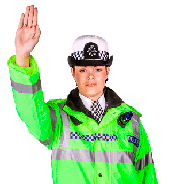
B
C
D
Correct Answer: A
Explanation: If a police officer or traffic warden directing traffic signals you to stop, you must obey them. They'll use the arm signals shown in The Highway Code. If they're controlling traffic where traffic lights have failed, react to their signal as though it had been given by the traffic lights.
Explanation: If a police officer or traffic warden directing traffic signals you to stop, you must obey them. They'll use the arm signals shown in The Highway Code. If they're controlling traffic where traffic lights have failed, react to their signal as though it had been given by the traffic lights.
72. There's a 'give way' sign where a one-way street joins a main road. What road markings would you see across the mouth of the junction?
Mark one answer
B
C
D
Correct Answer: D
Explanation: At the end of a one-way street, vehicles turning left will position on the left-hand side of the road and those turning right will use the right-hand side of the road. The double broken 'give way' lines will therefore run across the full width of the junction.
Explanation: At the end of a one-way street, vehicles turning left will position on the left-hand side of the road and those turning right will use the right-hand side of the road. The double broken 'give way' lines will therefore run across the full width of the junction.
Correct Answer: C
Explanation: As you approach a left-hand bend, control your speed so that you can deal with any hazard safely. Don't move out to the centre of the road to improve your view. This could put you too close to oncoming traffic. A vehicle coming the other way might be positioned on the crown of the road.
Explanation: As you approach a left-hand bend, control your speed so that you can deal with any hazard safely. Don't move out to the centre of the road to improve your view. This could put you too close to oncoming traffic. A vehicle coming the other way might be positioned on the crown of the road.
Correct Answer: B
Explanation: When driving in traffic, keep within your lane. Driving in the centre of your lane ensures there's as much space as possible between you and the traffic on either side. You should always follow the lane markings, which are there for two reasons: they make the best possible use of road space and they guide the traffic.
Explanation: When driving in traffic, keep within your lane. Driving in the centre of your lane ensures there's as much space as possible between you and the traffic on either side. You should always follow the lane markings, which are there for two reasons: they make the best possible use of road space and they guide the traffic.
75. Where are fluorescent green/yellow reflective studs used to mark the carriageway?
Mark one answer
B
C
D
Correct Answer: B
Explanation: Fluorescent green/yellow reflective studs indicate temporary lane changes, such as at roadworks and contraflow systems. The lanes are often narrower than normal lanes. You should obey any speed restrictions through the roadworks.
Explanation: Fluorescent green/yellow reflective studs indicate temporary lane changes, such as at roadworks and contraflow systems. The lanes are often narrower than normal lanes. You should obey any speed restrictions through the roadworks.
76. There are double white lines in the middle of the road. What does it mean when the line nearest to you is broken?
Mark one answer
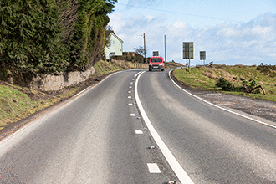
B
C
D
Correct Answer: A
Explanation: Where there are double white lines in the middle of the road and the line nearest to you is broken, you may cross the lines to overtake, provided it's safe and you can complete the manoeuvre before reaching a solid white line on your side.
Explanation: Where there are double white lines in the middle of the road and the line nearest to you is broken, you may cross the lines to overtake, provided it's safe and you can complete the manoeuvre before reaching a solid white line on your side.
77. You need to reverse park between two vehicles. As a guide, what's the minimum gap you'll need between the two vehicles?
Mark one answer
B
C
D
Correct Answer: B
Explanation: Reverse or parallel parking on the side of the road is a skill you need to learn as you prepare for your practical driving test. It will also help you to park safely and conveniently throughout your driving career. Once mastered, you should be able to park between two vehicles in a gap that would normally be about one-and-a-half times the length of your own vehicle.
Explanation: Reverse or parallel parking on the side of the road is a skill you need to learn as you prepare for your practical driving test. It will also help you to park safely and conveniently throughout your driving career. Once mastered, you should be able to park between two vehicles in a gap that would normally be about one-and-a-half times the length of your own vehicle.
Correct Answer: D
Explanation: Before stopping, check the mirrors to see what's happening behind you. Also assess what's ahead and make sure you give the correct signal if it will help other road users. If you have to stop in an emergency, you may not always have time to use the mirrors.
Explanation: Before stopping, check the mirrors to see what's happening behind you. Also assess what's ahead and make sure you give the correct signal if it will help other road users. If you have to stop in an emergency, you may not always have time to use the mirrors.
79. You're waiting at a level crossing. What must you do if a train has passed but the lights keep flashing?
Mark one answer
B
C
D
Correct Answer: A
Explanation: If the lights at a level crossing continue to flash after a train has passed, wait, as there might be another train coming. Time seems to pass slowly when you're held up in a queue. Be patient; there's a good safety reason why the barriers have remained down and the lights continue to flash.
Explanation: If the lights at a level crossing continue to flash after a train has passed, wait, as there might be another train coming. Time seems to pass slowly when you're held up in a queue. Be patient; there's a good safety reason why the barriers have remained down and the lights continue to flash.
Correct Answer: A
Explanation: You may only stop on the carriageway of a motorway
- when told to do so by the police
- when a red cross with flashing red lights shows above every lane - in a traffic jam
- in an emergency or breakdown.
Explanation: You may only stop on the carriageway of a motorway
- when told to do so by the police
- when a red cross with flashing red lights shows above every lane - in a traffic jam
- in an emergency or breakdown.
81. What should you do when you're driving through a contraflow system on a motorway?
Mark one answer
B
C
D
Correct Answer: B
Explanation: Obey any speed restriction in force and don't switch lanes or get too close to traffic in front of you. Be aware that there will be no permanent barrier between you and the oncoming traffic.
Explanation: Obey any speed restriction in force and don't switch lanes or get too close to traffic in front of you. Be aware that there will be no permanent barrier between you and the oncoming traffic.
Correct Answer: D
Explanation: If you're planning to make a journey when it's foggy, listen to the weather reports on the radio or television. Don't travel if visibility is very poor or your trip isn't necessary. If you do travel, leave plenty of time for your journey.
Explanation: If you're planning to make a journey when it's foggy, listen to the weather reports on the radio or television. Don't travel if visibility is very poor or your trip isn't necessary. If you do travel, leave plenty of time for your journey.
Correct Answer: D
Explanation: On occasions, other road users may make a mistake or lack judgement. When this happens, try not to let it annoy you. Don't react by showing anger, sounding your horn, flashing your headlights or shouting. A safe driver remains calm and makes allowances for others.
Explanation: On occasions, other road users may make a mistake or lack judgement. When this happens, try not to let it annoy you. Don't react by showing anger, sounding your horn, flashing your headlights or shouting. A safe driver remains calm and makes allowances for others.
Correct Answer: A
Explanation: Learners might not have confidence when they first start to drive. Allow them plenty of room and make allowances for their hesitation. We all learn from experience, but new drivers will have had less practice in dealing with all the situations that they meet.
Explanation: Learners might not have confidence when they first start to drive. Allow them plenty of room and make allowances for their hesitation. We all learn from experience, but new drivers will have had less practice in dealing with all the situations that they meet.
Correct Answer: A
Explanation: Traffic-calming measures, such as road humps, chicanes and narrowings, are intended to slow traffic down and to protect vulnerable road users. Maintain a reduced speed until you reach the end of the traffic-calming zone.
Explanation: Traffic-calming measures, such as road humps, chicanes and narrowings, are intended to slow traffic down and to protect vulnerable road users. Maintain a reduced speed until you reach the end of the traffic-calming zone.
86. What should you do if there are flashing amber lights under a school warning sign?
Mark one answer

B
C
D
Correct Answer: C
Explanation: The flashing amber lights are switched on to warn you that children may be crossing near a school. Slow down and take extra care, as you may have to stop.
Explanation: The flashing amber lights are switched on to warn you that children may be crossing near a school. Slow down and take extra care, as you may have to stop.
87. You're driving on a road that has double solid white lines in the middle of the road. When may you cross these lines to overtake?
Mark one answer
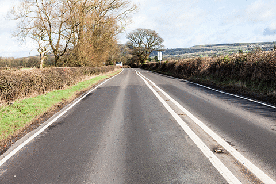
B
C
D
Correct Answer: C
Explanation: If it's safe to do so, you may cross a solid white line to pass a road maintenance vehicle, pedal cycle or horse, if they're travelling at 10 mph (16 km/h) or less. When safe, you may also cross the solid line to enter a side road, access a property or pass a stationary vehicle.
Explanation: If it's safe to do so, you may cross a solid white line to pass a road maintenance vehicle, pedal cycle or horse, if they're travelling at 10 mph (16 km/h) or less. When safe, you may also cross the solid line to enter a side road, access a property or pass a stationary vehicle.
Correct Answer: C
Explanation: Long vehicles might have to take a slightly different position when approaching the roundabout or going around it. This is to stop the rear of the vehicle cutting in and mounting the kerb. Horse riders and cyclists might stay in the left-hand lane although they're turning right. Be aware of this and allow them room.
Explanation: Long vehicles might have to take a slightly different position when approaching the roundabout or going around it. This is to stop the rear of the vehicle cutting in and mounting the kerb. Horse riders and cyclists might stay in the left-hand lane although they're turning right. Be aware of this and allow them room.
B
C
D
Correct Answer: D
Explanation: The speed limit on a dual carriageway or motorway is 70 mph for cars and motorcycles, unless there are signs to indicate otherwise. If your car or motorcycle is towing a trailer, then a lower national speed limit applies. The speed limits for different types of vehicle are listed in The Highway Code.
Explanation: The speed limit on a dual carriageway or motorway is 70 mph for cars and motorcycles, unless there are signs to indicate otherwise. If your car or motorcycle is towing a trailer, then a lower national speed limit applies. The speed limits for different types of vehicle are listed in The Highway Code.
Correct Answer: D
Explanation: Reflective studs are placed along the edges and between the lanes on motorways. The colour of the stud can help you identify your position on the road when visibility is reduced; for example, when it's foggy. Between the lanes, the studs are white. Red studs are used between the left-hand edge of the carriageway and the hard shoulder. Amber studs are used along the right-hand edge of the carriageway, and green studs are used where slip roads enter or leave the motorway.
Explanation: Reflective studs are placed along the edges and between the lanes on motorways. The colour of the stud can help you identify your position on the road when visibility is reduced; for example, when it's foggy. Between the lanes, the studs are white. Red studs are used between the left-hand edge of the carriageway and the hard shoulder. Amber studs are used along the right-hand edge of the carriageway, and green studs are used where slip roads enter or leave the motorway.
91. You're driving on a motorway. What must you do if you see this signal above every lane?
Mark one answer
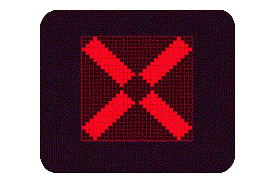
B
C
D
Correct Answer: C
Explanation: Red flashing lights above every lane mean you mustn't go on any further. You'll also see a red cross illuminated. Stop and wait. Don't
- change lanes
- continue
- stop on the hard shoulder (unless in an emergency).
Explanation: Red flashing lights above every lane mean you mustn't go on any further. You'll also see a red cross illuminated. Stop and wait. Don't
- change lanes
- continue
- stop on the hard shoulder (unless in an emergency).
B
C
D
Correct Answer: A
Explanation: Use the hard shoulder to gain speed and indicate your intention, but don't force your way into the traffic. Wait for a safe gap in the traffic in the left-hand lane before you rejoin the main carriageway.
Explanation: Use the hard shoulder to gain speed and indicate your intention, but don't force your way into the traffic. Wait for a safe gap in the traffic in the left-hand lane before you rejoin the main carriageway.
93. What should you do when you approach a bus signalling to move away from a bus stop?
Mark one answer
B
C
D
Correct Answer: A
Explanation: Give way to buses if you can do so safely, especially when they signal to move off from a bus stop. Look out for people who've just got off the bus, as they may try to cross the road. Don't try to accelerate past before the bus starts moving, and don't flash your headlights; other road users may be misled by this signal.
Explanation: Give way to buses if you can do so safely, especially when they signal to move off from a bus stop. Look out for people who've just got off the bus, as they may try to cross the road. Don't try to accelerate past before the bus starts moving, and don't flash your headlights; other road users may be misled by this signal.
94. You're driving in a town and want to turn left at a junction. What should you do if pedestrians are crossing at the junction?
Mark one answer
B
C
D
Correct Answer: B
Explanation: If you're turning into a side road, pedestrians already crossing the road have priority and you should give way to them. Don't
-wave them across the road
-sound your horn
-flash your headlights
-give any other misleading signal - other road users may misinterpret your signal and you might lead the pedestrian into a dangerous situation.
If a pedestrian is slow or indecisive, be patient and wait. Don't hurry them across by revving your engine.
Explanation: If you're turning into a side road, pedestrians already crossing the road have priority and you should give way to them. Don't
-wave them across the road
-sound your horn
-flash your headlights
-give any other misleading signal - other road users may misinterpret your signal and you might lead the pedestrian into a dangerous situation.
If a pedestrian is slow or indecisive, be patient and wait. Don't hurry them across by revving your engine.
95. You're driving in a one-way street. Where should you position the car to turn right?
Mark one answer
B
C
D
Correct Answer: C
Explanation: If you're travelling in a one-way street and wish to turn right, you should take up a position in the right-hand lane. This will enable other road users not wishing to turn to keep going on the left. Indicate your intention and take up your position in good time.
Explanation: If you're travelling in a one-way street and wish to turn right, you should take up a position in the right-hand lane. This will enable other road users not wishing to turn to keep going on the left. Indicate your intention and take up your position in good time.
Correct Answer: D
Explanation: Diamond-shaped signs apply to tram drivers. You should know their meaning so that you're aware of the priorities and are able to anticipate the actions of the driver.
Explanation: Diamond-shaped signs apply to tram drivers. You should know their meaning so that you're aware of the priorities and are able to anticipate the actions of the driver.
97. You're in a line of traffic. What action should you take if the driver behind you is following very closely?
Mark one answer
B
C
D
Correct Answer: D
Explanation: It can be worrying if the driver behind hasn't left enough room to stop if you have to brake hard - for example, in an emergency. Driving defensively, you should give yourself a greater safety margin by easing back from the vehicle in front. If an emergency arises, you'll be able to slow down more gradually, giving the driver behind more time to respond.
Explanation: It can be worrying if the driver behind hasn't left enough room to stop if you have to brake hard - for example, in an emergency. Driving defensively, you should give yourself a greater safety margin by easing back from the vehicle in front. If an emergency arises, you'll be able to slow down more gradually, giving the driver behind more time to respond.
98. You're following a vehicle on a wet road. What time gap should you leave between your vehicle and the one in front?
Mark one answer
B
C
D
Correct Answer: A
Explanation: Wet roads will reduce your tyres' grip on the road. The safe separation gap of at least two seconds in dry conditions should be doubled in wet weather.
Explanation: Wet roads will reduce your tyres' grip on the road. The safe separation gap of at least two seconds in dry conditions should be doubled in wet weather.
Correct Answer: A
Explanation: Pelican crossings are signal-controlled crossings operated by pedestrians. Push-button controls change the signals. Pelican crossings have no red-and-amber stage before green. Instead, they have a flashing amber light, which means you must give way to pedestrians on the crossing, but if it's clear, you may continue.
Explanation: Pelican crossings are signal-controlled crossings operated by pedestrians. Push-button controls change the signals. Pelican crossings have no red-and-amber stage before green. Instead, they have a flashing amber light, which means you must give way to pedestrians on the crossing, but if it's clear, you may continue.
B
C
D
Correct Answer: A
Explanation: At a crossroads where there are no 'give way' signs or road markings, no-one has priority, even if the roads are of different sizes. Approach slowly and only cross when the junction is clear.
Explanation: At a crossroads where there are no 'give way' signs or road markings, no-one has priority, even if the roads are of different sizes. Approach slowly and only cross when the junction is clear.



